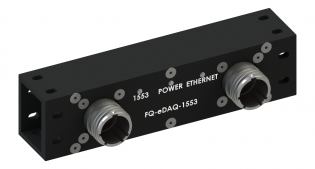Bridging between legacy data buses and Ethernet
As more and more avionics systems begin to employ the use of Ethernet, there are an increasing number of application requirements for devices to operate as a bridge between Ethernet networks and MIL-STD-1553 bus systems. A few of the types of applications for MIL-STD-1553 to Ethernet bridges are:
- Flight Test Data Acquisition
- Avionics Gateways
- Avionics Systems Integration Labs
Flight Test Data Acquisition
In Flight Test data systems MIL-STD-1553 bus data must commonly be acquired for streaming into a flight test data recorder. Additionally, it is a common requirement for MIL-STD-1553 bus data to be streamed to a Telemetry gateway for transmission to a ground station during a flight test.

When MIL-STD-1553 data is streamed to a flight test data recorder a common standard format for the data stream is IRIG 106 Chapter 10. For MIL-STD-1553 data streamed to a Telemetry system, the bus data can be encoded using the Telemetry Network System (TmNS) Data Message format. There are currently data acquisition units available as off the shelf products which provide support for streaming MIL-STD-1553 both IRIG Ch.10 and TmNS data formates.
Avionics Systems Gateway
For an increasing number of new applications MIL-STD-1553 data bus is required as input to the new avionics device (but the new device does NOT have to provide data back to the MIL-STD-1553 bus system). In this type of application, it is desirable to have a simple passive, monitoring device attached to the MIL-STD-1553 bus which is capable of forwarding selected data to remote systems via an Ethernet network. For these types of applications a common strategy is to associate a specific User Datagram Protocol (UDP) port with a MIL-STD-1553 Remote Terminal (RT) address and Remote Terminal Subaddress (SA). For each MIL-STD-1553 bus transaction associated with the RT & SA the gateway will generate a UDP message to the associated port to "reflect" the RT Subaddress data item on the Ethernet network. The data can be sent to IP multicast groups in order to make it available to multiple systems attached to the Ethernet network.
System Integration Labs
In a systems integration lab, or a maintenance depot it is often desirable for several users to have access to MIL-STD-1553 bus data from a system under test. In the past, this usually required each user to have MIL-STD-1553 bus monitoring device, for example a USB device capable of monitoring MIL-STD-1553 bus data for display on the attached PC host. A single MIL-STD-1553 to Ethernet bridge device can simplify this type of application and reduce the need for test equipment by providing the bus data to multiple users on multiple PC host systems from a single device. In this type of application the bridge can simply capture all of the MIL-STD-1553 bus data an multicast it on an Ethernet LAN. And host system on the LAN can then access the data by subscribing to the IP multicast group. IRIG 106 Chapter 10 is a useful format for the MIL-STD-1553 data on the Ethernet LAN because there are many IRIG Ch.10 software tools readily available for viewing data on the network in this format.


